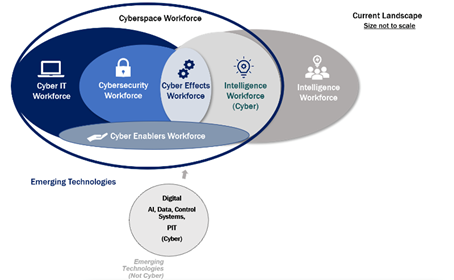NICE eNewsletter Spring 2022 Government Spotlight
Department Of Defense 8140 Policy Series: Management Tools for the Defense Cyberspace Workforce
By The Department of Defense Chief Information Officer, Cyber Workforce Management Directorate
The Office of the United States (U.S.) Department of Defense (DoD) Chief Information Officer (CIO) works with federal and private sector partners to continuously reduce the number of cybersecurity threats the U.S. faces every day. Through this collaborative effort, the DoD CIO can strengthen cyberspace defensive and offensive capabilities, as well as protect critical assets. In collaboration with federal partners, the Cyber Workforce Management Directorate (CWMD) developed the DoD 8140 policy series to strategically identify, develop, and qualify cyberspace professionals.
The implementation of the DoD 8140 policy series affords a comprehensive cyberspace workforce management approach across civilian, military, and contractor populations. The policy series takes a targeted, role-based approach to identify and develop cyberspace personnel using the DoD Cyber Workforce Framework (DCWF). Notably, the policy series focuses on demonstration of capability, rather than compliance-based requirements, and can be used as additional management tools for the cyberspace workforce. This compliance-based approach ensures the Department is able to address the ever-evolving cyberspace needs in a competitive national environment.

The Cyberspace Workforce[1] is defined as personnel who build, secure, operate, defend, and protect the DoD and U.S. cyberspace resources; conduct related intelligence activities; enable future operations; and protect power in or through cyberspace. It is comprised of personnel assigned to the areas of Cyber Effects, Cybersecurity, Cyber IT, Cyber Enablers, and portions of the Intelligence Workforce (shown to the right).
8140 POLICY SERIES
The DoD 8140 policy series prescribes standards and assigns responsibilities for the management of the DoD cyberspace workforce to include the identification, tracking, qualification, and reporting of the workforce. The DoD 8140 Policy Series includes three distinct policies: a directive, an instruction, and a manual (currently in draft form), that work together to unify management of the DoD cyberspace workforce.
DoD Directive (DoDD) 8140.01 “Cyberspace Workforce Management” establishes a definition for the cyberspace workforce, introduces the DCWF as an authoritative reference, and outlines DoD Component roles and responsibilities for the management of the DoD cyberspace workforce. The directive was effective October 5, 2020.
DoD Instruction (DoDI) 8140.02 “Identification, Tracking, and Reporting of Cyberspace Workforce Requirements” covers the identification, tracking, and reporting of the cyberspace workforce in accordance with the DCWF, enabling enterprise strategic workforce planning efforts. The instruction was effective December 21, 2021.
PROFICIENCY LEVELS
The three proficiency levels that define performance expectations for the policy series are:
1. Basic. The role requires an individual to have familiarity with basic concepts and processes and the ability to apply these with frequent, specific guidance. An individual must be able to perform successfully in routine, structured situations.
2. Intermediate. The role requires an individual to have extensive knowledge of basic concepts and processes and experience applying these with only periodic high-level guidance. An individual must be able to perform successfully in non-routine and sometimes complicated situations.
3. Advanced. The role requires an individual to have an in-depth understanding of advanced concepts and processes and experience applying these with little to no guidance. An individual must be able to provide guidance to others; and the work must be performed as a primary or additional work role, pursuant to Paragraph 4.1.b of the DoDI 8140.02.
CYBERSPACE WORKFORCE METRICS
At a minimum, the DoD components provide updates annually to the Cyberspace Workforce Management Board (CWMB) to aid the DoD in managing the health, welfare, and maturity of the cyberspace workforce.
Qualifying the Cyberspace Workforce
Draft DoD Manual (DoDM) 8140.AC “Cyberspace Workforce Qualification and Management Program” (anticipated publication date 3rd-4th quarter of FY22) establishes the qualification criteria for each DCWF work role to ensure personnel filling cyberspace positions are capable of meeting mission requirements. This policy will provide the DoD with flexibility needed across varied cyberspace mission sets, while it moves away from a compliance-based approach to help advance individual career progression and workforce capabilities. The qualification program is broken into three areas:
- Foundational qualification focused on demonstration of knowledge;
- Residential qualification focused on demonstration of capability; and
- Continuous professional development to ensure knowledge and capabilities are maintained over time as tools, technology, tactics, and techniques evolve.
The 8140 policy series are essential management tools that stakeholders can use as the department strengthens its cyberspace capabilities in a competitive national environment. All DoD Cyberspace Workforce related inquiries and questions can be sent to: osd.cyberspaceworkforce-tag [at] mail.mil (OSD[dot]CyberspaceWorkforce-TAG[at]mail[dot]mil).
[1] Defined in the DoD Directive 8140.01 (https://www.esd.whs.mil/Portals/54/Documents/DD/issuances/dodd/814001p…) on page 12, as the following: Personnel who build, secure, operate, defend, and protect DoD and U.S. cyberspace resources; conduct related intelligence activities; enable future operations; and project power in or through cyberspace. It is comprised of personnel assigned to the following workforce elements: IT, cybersecurity, cyberspace effects, intelligence workforce (cyberspace), cybersecurity, IT, portions of the Intelligence workforces and cyberspace enablers.

